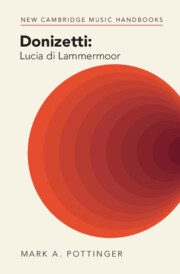Book contents
- Donizetti: Lucia di Lammermoor
- New Cambridge Music Handbooks
- Donizetti: Lucia di Lammermoor
- Copyright page
- Contents
- Figures
- Musical Examples
- Introduction: Why Lucia?
- Acknowledgements
- A Note on Editions and Translations
- Opera Summary
- 1 Source Studies
- 2 Speaking of Genre: Lucia and the Bel Canto Tradition
- 3 The Sonic Landscape: The Orchestral Prelude and Score
- 4 Act I: The Departure
- 5 Act II: The Nuptial Agreement
- 6 Act III: The Wedding Night and the Graveyard at Dawn
- 7 Reception and Legacy
- Book part
- Bibliography
- Index
1 - Source Studies
Published online by Cambridge University Press: 06 November 2025
- Donizetti: Lucia di Lammermoor
- New Cambridge Music Handbooks
- Donizetti: Lucia di Lammermoor
- Copyright page
- Contents
- Figures
- Musical Examples
- Introduction: Why Lucia?
- Acknowledgements
- A Note on Editions and Translations
- Opera Summary
- 1 Source Studies
- 2 Speaking of Genre: Lucia and the Bel Canto Tradition
- 3 The Sonic Landscape: The Orchestral Prelude and Score
- 4 Act I: The Departure
- 5 Act II: The Nuptial Agreement
- 6 Act III: The Wedding Night and the Graveyard at Dawn
- 7 Reception and Legacy
- Book part
- Bibliography
- Index
Summary
Salvadore Cammarano’s libretto is based on the historical novel The Bride of Lammermoor by Walter Scott and thus invites us to examine the real-life sources for Scott’s published work. In addition, as the Scott work was published in 1819, it follows on the heels of the more famous novel by Mary Shelley, Frankenstein; or, the Modern Prometheus in 1818. Shelley’s gothic novel reveals a similar fascination with the sociopolitical environment of the early Enlightenment, as well as the spectres of madness, murder and the private lives of individuals caught up in vengeful forces beyond their control. Beyond the literary sources for the libretto, the opera also bears witness to the use of medical knowledge in defining the appearance and sound of a mentally ill young woman who has succumbed to hysteria. According to medical treatises of the time, hysteria was a disease that bore physical and emotional symptoms, the severity of which could be diagnosed with the relatively new invention of the stethoscope (1816). As Donizetti’s work premiered during a time of heightened listening, whereby audiences sought to hear within the notes of the music the inner world of the composer or the performer, the sound of pain or latent disease was now understood to reflect a lexicon of medically understood sounds that reveal themselves to the careful listener.
Keywords
Information
- Type
- Chapter
- Information
- Donizetti: Lucia di Lammermoor , pp. 1 - 33Publisher: Cambridge University PressPrint publication year: 2025
Accessibility standard: Inaccessible, or known limited accessibility
Why this information is here
This section outlines the accessibility features of this content - including support for screen readers, full keyboard navigation and high-contrast display options. This may not be relevant for you.Accessibility Information
Content Navigation
Allows you to navigate directly to chapters, sections, or non‐text items through a linked table of contents, reducing the need for extensive scrolling.
Provides an interactive index, letting you go straight to where a term or subject appears in the text without manual searching.
Reading Order & Textual Equivalents
You will encounter all content (including footnotes, captions, etc.) in a clear, sequential flow, making it easier to follow with assistive tools like screen readers.
You get concise descriptions (for images, charts, or media clips), ensuring you do not miss crucial information when visual or audio elements are not accessible.
Visual Accessibility
You will still understand key ideas or prompts without relying solely on colour, which is especially helpful if you have colour vision deficiencies.
Structural and Technical Features
You gain clarity from ARIA (Accessible Rich Internet Applications) roles and attributes, as they help assistive technologies interpret how each part of the content functions.
